Overview
Within This Page
The office building is a very tangible reflection of a profound change in employment patterns that occurred over the last one hundred years. In the U.S., northern Europe, and Japan, at least 50 percent of the working population is employed in office settings as compared to 5 percent of the population at the beginning of the 20th century. However, today's office buildings are experiencing even more change due to the recent pandemic. The office is now a place for collaboration, talent recruitment, onboarding, and inspiration with new requirements and expectations that combine physical spaces with technologically supported ways to work, in the office or remotely.
Typically, the life-cycle cost distribution for a typical service organization is about 3 to 4 percent for the facility, 4 percent for operations, 1 percent for furniture, and 90 to 91 percent for salaries. As such, if the office structure can leverage the 3 to 4 percent expenditure on facilities to improve the productivity of the workplace, it can have a very dramatic effect on personnel contributions representing 90 to 91 percent of the service organization's costs.
To accomplish this objective, the office building must benefit from an integrated design approach that focuses on meeting a list of design objectives. Through integrated design, high-performance office buildings offers owners and users increased worker satisfaction and productivity, improved health, greater flexibility, and enhanced energy and environmental performance. Typically, these projects apply life-cycle analysis to optimize initial investments in architectural design, systems selection, and building construction.
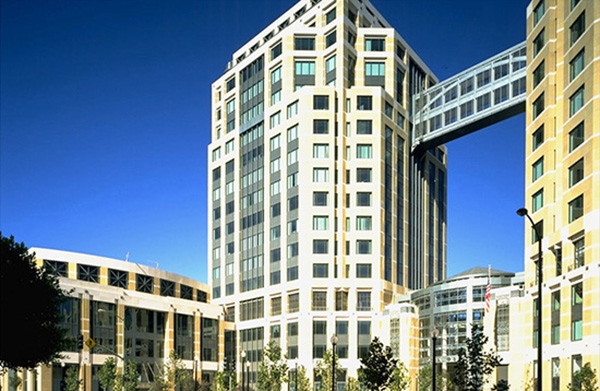
The Ronald V. Dellums Federal Building and U.S. Courthouse complex in Oakland, California, consists of two identical towers topped with pyramid-shaped roofs. The towers are connected by a ground level rotunda and an elevated sky bridge. The podium of one of the towers houses a federal courthouse and the other houses a post office and conference center.
Photo Credit: Kaplan McLaughlin Diaz
Building Attributes
An office building must have flexible and technologically-advanced working environments that are safe, healthy, comfortable, durable, aesthetically-pleasing, sustainable, and accessible. It must be able to accommodate the specific space and equipment needs of the tenant. Special attention should be made to the selection of interior finishes and art installations, particularly in entry spaces, conference rooms and other areas with public access.
A. Types of Spaces
An office building incorporates a number of space types to meet the needs of staff and visitors. These may include:
Offices
- Offices: May be private or semi-private acoustically and/or visually.
- Conference Rooms
Employee/Visitor Support Spaces
- Convenience Store, Kiosk, or Vending Machines
- Lobby: Central location for building directory, schedules, and general information
- Atria or Common Space(s): Informal, multi-purpose recreation and social gathering space(s)
- Cafeteria or Dining Hall
- Private Toilets, Restrooms, and Showers
- Child Care Centers
- Physical Fitness Area
- Interior or Surface Parking Areas
Administrative Support Spaces
- Administrative Offices: May be private or semi-private acoustically and/or visually.
Operation and Maintenance Spaces
- General Storage: For items such as stationery, equipment, and instructional materials.
- Food Preparation Area or Kitchen
- Computer/Information Technology (IT) Closets or data processing areas. See WBDG Automated Data Processing: PC System related information.
- Maintenance Closets
B. Important Design Considerations
Typical features of Office Buildings include the list of applicable design objectives elements as outlined below. For a complete list and definitions of the design objectives within the context of whole building design, click on the titles below.
Accessible
The ADA requires that all new construction of places of public accommodation, as well as of commercial facilities such as office buildings, be accessible. The ADA Standards for Accessible Design set minimum requirements—both scoping and technical—for newly designed and constructed or altered public accommodations and commercial facilities to be readily accessible to and usable by individuals with disabilities. Several of the key elements are outlined below. However, it is important to utilize the full standard to determine all requirements.
-
Accessible Parking, Entrances, and Routes: Office buildings should have accessible parking, entrances, and accessible routes within the spaces that can accommodate persons with various disabilities, including wheelchairs. Office furniture should be placed a minimum of 32" from walls and other obstructions to allow for smooth wheelchair passages. Allow 60" clearance so wheelchairs can rotate and turn around corners.
-
Accessible Countertops and Work Stations: Accommodate different employee needs through the use of standing and/or adjustable desks, and work surfaces and countertops that are modifiable. Desks should be 24–36" high. Standard desks are usually 30" high. Employees should not have to reach any higher than 48" and no lower than 15". When an employee needs to reach to the side, items should be no higher than 54" and no lower than 9". Incorporate Universal Design principles to achieve a design that works for all whenever possible.
-
Assistive Technology: Plan for employees with disabilities who require special assistive technology, as well as employees who use a large amount of technology that is not portable.
-
Toilet Rooms and Bathing Spaces: Provide accessible toilet rooms and bathing spaces as defined and required by the ADA.
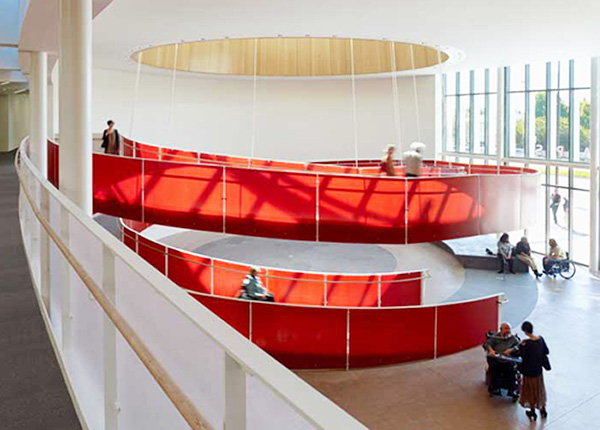
A spiraling ramp with bright red walls at the transit-oriented Ed Roberts Campus in Berkeley, California, designed by Leddy Maytum Stacy Architects, offers an accessible and visually appealing way to move between floors.
Photo Credit: Tim Griffith
Aesthetics
-
Planning: When planning the exterior and interiors of an office building, create a building design and spaces that businesses and people want to work in. Aesthetics are extremely significant to both morale and productivity within the workplace. The office building should also be planned to accommodate changes in use or work flow.
-
Overall Aesthetics: Utilize color, pattern, and texture in the building to create an inviting and safe environment. Furnishings, finishes, and artwork should reflect the nature of the work within the building and be well taken care of and provide supportive and comfortable environments. Provide access to views and nature whenever possible to improve the quality of the work environment. Provide aesthetically pleasing individual work spaces and storage. Encourage some personalizing of space, but eliminate clutter to reduce distractions and work hazards.
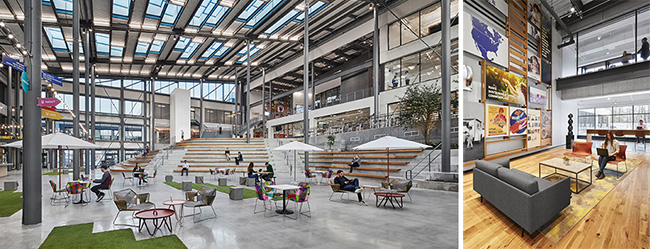
The North American headquarters of consumer goods company Unilever, was overhauled by Perkins + Will with new communal areas to create a showpiece office that incorporates smart technology, is sustainable and Instagram-ready, and makes employees feel like they are in Manhattan. Traditional, cellular layouts were replaced with open workspaces, huddle rooms, and lounges.
Photo Credits: Perkins+Will
Cost-Effective
The high-performance office should be evaluated using life-cycle economic and material evaluation models. Owners need to understand that optimizing building performance requires a willingness to invest more initially to save on long-term operations and maintenance costs.
To achieve the optimum performance for the investment in the facility, value engineering provides a means for assessing the performance versus cost of each design element and building component. In the design phase building development, properly applied value engineering considers alternative design solutions to optimize the expected cost/worth ratio of projects at completion. Value engineering elicits ideas on ways of maintaining or enhancing results while reducing life-cycle costs. In the construction phase, contractors are encouraged through shared savings to draw on their special 'know-how' to propose changes that cut costs while maintaining or enhancing quality, value, and functional performance. For more information on value-engineering, see WBDG Cost-Effective—Utilize Cost and Value Engineering Throughout the Project Life Cycle.
Functional/Operational
Tenant Requirements: The building design must consider the integrated requirements of the intended tenants. This includes their desired image, degree of public access, operating hours, growth demands, security issues, and vulnerability assessment results, organization and group sizes, growth potential, long-term consistency of need, group assembly requirements, electronic equipment and technology requirements, acoustical requirements, special floor loading and filing/storage requirements, special utility services, any material handling or operational process flows, special health hazards, use of vehicles and types of vehicles used, and economic objectives.

Office layouts have become more open, supporting opportunities for easy collaboration, access to technology, and healthy settings that include natural daylight and views.
Photo Credit: Alesia Kazantceva on Unsplash
Flexibility
The high-performance office must easily and economically accommodate frequent renovation and alteration, sometimes referred to as "churn." These modifications may be due to management reorganization, personnel shifts, changes in business models, or technological innovations, but the office infrastructure, interior systems, and furnishings must be up to the challenge.
-
Consider raised floors to allow for easy access to cabling and power distribution, as well as advanced air distribution capabilities to address individual occupant comfort.
-
Incorporate features such as plug-and-play floor boxes for power, data, voice and fiber, modular and harnessed wiring and buses, and conferencing hubs to allow for daily flexibility at work as well as future reorganization of office workstations.
-
Plan for the hybrid office model to allow some employees to work in the office, while others may remain working remotely. Distanced layouts, separated cubicles, more personal space, contactless pathways, one-way hallways, distanced desks, disposable surface protectors, and signage to direct the flow of employees and visitors are elements of hybrid office design.
Urban and Site Planning
The concentration of a large number of workers within one building can have a significant impact on surrounding areas and neighborhoods. Office structures can vitalize neighborhoods with the retail, food service, and interrelated business links the office brings to the neighborhood. Consideration of transportation issues must also be given when developing office structures. Office buildings are often impacted by urban planning and municipal zoning, which attempt to promote compatible land use and vibrant neighborhoods.
-
Consider previously developed sites or brownfield sites for the development of a new office building to reduce the impact on land use and natural habitats. Also, consider existing buildings that can be retrofitted to reduce the use of resources needed to create a new building while also minimizing the disturbance of new sites.
-
When selecting office locations, consideration should be given to the travel distance the majority of occupants will have to reach the office. Studies including zip code origination should be conducted to determine the best location for the office. The development of new office locations may necessitate relocation of employees, particularly if the office is moved or opened in a new geographical area. Consideration of the municipal resources should include housing costs and availability, traffic congestion, school system quality, cultural resources such as museums, sports teams, and institutions of higher education, natural attractions such as coastal, riverfront, and lakefront areas, mountains, and public parks, availability of educated labor, crime rate and law enforcement, and civic infrastructure capacity such as water, waste water, and waste processing.
-
Once a building has been constructed and occupied, it is critical that long-term performance be optimized through an aggressive process of metering, monitoring, and reporting. The results of this feedback should inform maintenance operations and be available as input to new design efforts.
Productive
Worker Satisfaction, Health, and Comfort: In office environments, the single greatest cost to employers is the salaries of the employees occupying the space. It generally exceeds the lease and energy costs of a facility by a factor of ten on a square foot basis. For this reason, the health, safety, and comfort of employees in a high-performance office are of paramount concern.
-
Utilize strategies such as increased natural ventilation rates, the specification of non-toxic and low-polluting materials and systems, and indoor air quality monitoring.
-
Provide individualized climate control that permits users to set their own, localized temperature, ventilation rate, and air movement preferences.
-
It is widely accepted that worker satisfaction and performance increases when office workers are provided stimulating, dynamic working environments. Access to windows and views, opportunities for interaction, and control of one's immediate environment are some of the factors that contribute to improved workplace satisfaction. See also the Psychosocial Value of Space.
-
Natural light is important to the health and psychological well-being of office workers. The design of office environments must place emphasis on providing each occupant with access to natural light and views to the outside. A minimum of 30 foot candles per square foot of diffused indirect natural light is desirable.
-
The acoustical environment of the office must be designed and integrated with the other architectural systems and furnishings of the office. Special consideration must be given to noise control in open office settings, with absorptive finish materials, masking white noise, and sufficient separation of individual occupants.
Technical Connectivity
Technology is an indispensable tool for business, industry, and education. Given that technology is driving a variety of changes in the organizational and architectural forms of office buildings, consider the following issues when incorporating it, particularly information technology (IT), into an office:
-
Plan new office buildings to have a distributed, robust, and flexible IT infrastructure, which allows technological access in virtually all spaces.
-
During the planning stage, identify all necessary technological systems (e.g., voice/cable/data systems such as audio/visual systems, speaker systems, Internet access, and Local Area Networks [LAN] / Wide-Area Networks [WAN] / Wireless Fidelity [WI-FI]), and provide adequate equipment rooms and conduit runs for them.
-
Consider and accommodate wireless technologies, as appropriate.
-
Combine smart building technologies, smartphone apps, and wearable sensors to transform the post-pandemic workplace into much safer spaces. Data can also be captured from these technologies to optimize the spaces and make them more convenient for users.
-
For existing office buildings, improve access to the IT infrastructure as renovations are undertaken.
See WBDG Productive—Design for the Changing Workplace and Productive—Integrate Technological Tools for more information about incorporating IT into facility design.
Secure / Safe
Office building security begins at the site perimeter or property line. This includes planning for access to the site, parking, walkways, and security elements that protect the building during the day and at night. Focus the design on protection of occupants and assets against manmade attacks as well as natural hazards. Through comprehensive threat assessment, vulnerability assessment, and risk analysis, security requirements for individual buildings are identified, and appropriate reasonable design responses are identified for integration into the office building design.
-
Consider entrances that do not face uncontrolled vantage points with direct lines of sight to the entrance. Utilize site barriers and setbacks, perimeter barriers and blast resistance, access control, and intrusion detection, entrance screening, package screening and control, open areas that allow for easy visual detection by occupants, and minimized glazing. See WBDG Secure / Safe—Security for Building Occupants and Assets.
-
First-time visitors, unfamiliar with their surroundings, may have trouble navigating the safest exit route from the building. Consider using increased signage and/or providing safety information and a building directory in welcome brochures. Also, review and evaluate safety plans on a regular basis. See WBDG Secure / Safe—Fire Protection and Secure / Safe—Occupant Safety and Health.
-
Utilize CPTED principles to proactively design security into the project without compromising aesthetics, but that also provide cost savings, improved quality of life for building users, and decreased loss and liability.
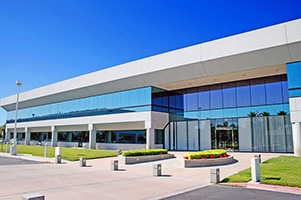
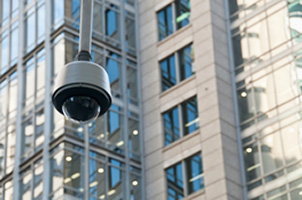
Bollards installed at an office building perimeter.
Photo Credit: Reliance Foundry
A CCTV surveillance security dome on the exterior of a corporate office building.
Photo Credit: Dreamstime
Sustainable
- Energy Efficiency: Depending on the office's size, local climate, use profile, and utility rates, strategies for minimizing energy consumption include:
- reducing the building's energy loads (by integrating the building with the site, optimizing the building envelope [decreasing infiltration, increasing insulation], etc.);
- correctly sizing and optimizing the heating, ventilating, and air-conditioning systems;
- installing high-efficiency equipment, lighting, and appliances.
-
Alternative Energy: Consideration should be given to the application of renewable energy systems such as building-integrated photovoltaic systems that generate building electricity, solar thermal systems that produce hot water for domestic hot water (DHW) or space conditioning, or geothermal heat pump systems that draw on the thermal capacitance of the earth to improve HVAC system performance. Additional consideration should be given to the applications of other distributed energy sources, including microturbines, fuel cells, etc., that provide reliability (emergency and mission critical power) and grid-independence, and reduce reliance on fossil fuel grid power.
-
Materials and Resources: Building materials and resources should be durable and sustainable to reduce environmental impacts, long-term operations and maintenance costs, and promote indoor environmental quality.
-
Water Efficiency: Incorporate water saving fixtures and equipment to protect and conserve water. Also plan for landscaping that requires little to no water use. Recover non-sewage and graywater for on-site use (such as toilet flushing and landscape irrigation, and more generally, consider the water quality requirements of each water use).
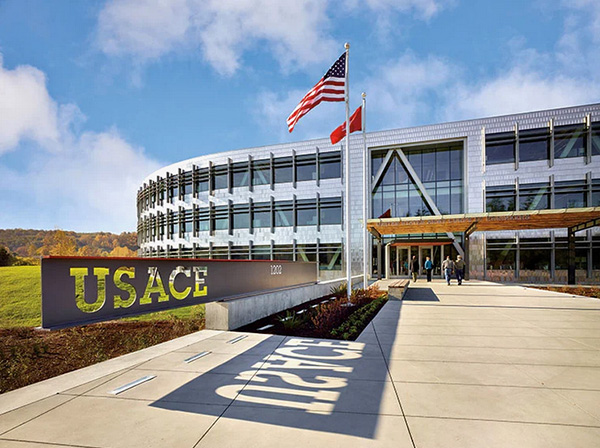
The Federal Center South building transformed a 4.6 acre brownfield site into a highly flexible and sustainable 209,000 SF regional headquarters for the U.S. Army Corps of Engineers (USACE) Northwest District. The project also incorporated biophilia to improve the connection to nature and increase worker productivity and happiness.
Photo Credit: Benjamin Benschneider
C. Example Design and Construction Criteria
For GSA, the unit costs for this building type are based on the construction quality and design features in the following table . This information is based on GSA's benchmark interpretation and could be different for other owners.
Emerging Issues
Modernization
The extensive inventory of facilities that are over 25 years of age present a significant recapitalization challenge as well as an opportunity. For GSA, its First Impressions Program addresses the quality of the entrance and lobby areas of its older facility portfolio. Key areas of concern for modernization include upgrading the exterior envelope, mechanical systems, telecommunications infrastructure, security, and interior finishes. Improving the workplace quality, energy performance, security, flexibility to accommodate tenant churn, maintenance overhead, and life-cycle expectancy are important objectives for modernizing these facilities. Appropriate preservation for buildings on or eligible to be on the historic registry is part of the modernization effort.
Commissioning
With the continuation of improved building technologies and controls it is crucial that high-performance buildings are properly commissioned as part of a comprehensive quality assurance plan. In many instances, a process of ongoing commissioning has shown to be effective.
Some federal agencies and private institutions are moving aggressively in the direction of mandating commissioning for all high-performance structures in their portfolios.
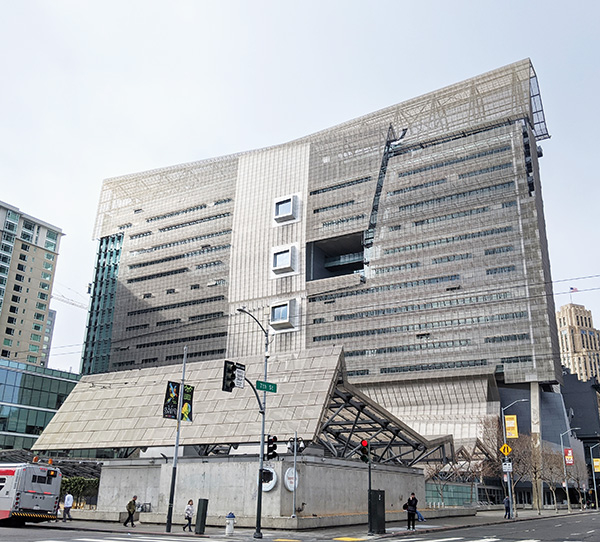
This Federal Building in San Francisco, California earned LEED Silver from the USGBC. The building's shape and orientation maximize natural airflow for cooling and ventilation and take advantage of natural daylight for the majority of the open office interiors.
Photo Credit: Morphosis Architects
Relevant Codes and Standards
There is a wide range of criteria, codes, and standards that cover federal and private sector office building design. General criteria and guidance for office building design for federal facilities can be found in:
- Americans with Disabilities Act (ADA) and Architectural Barriers Act (ABA) Accessibility Guidelines U.S. Access Board
- PBS-P100 Facilities Standards for the Public Buildings Service by the General Services Administration (GSA)
- Requirements and Specifications for Special Purpose and Support Space Manual, Volume 1–4 by the General Services Administration (GSA)
- UFC 1-200-01 DoD Building Code
- UFC 4-610-01N Administrative Facilities
- U.S. Courts Design Guide Judiciary Conference
- WELL Building Standard International WELL Building Institute
Additional Resources
Organizations and Associations
- The American Institute of Architects (AIA)
- American Society of Interior Designers (ASID)
- Building Owners and Managers Association (BOMA)
- International Facility Managers Association (IFMA)
- International Living Future Institute (ILFI)
- U.S. Green Building Council (USGBC)
Publications
- Architectural Graphic Standards, 12th Edition by The American Institute of Architects, Dennis J. Hall. New York, NY: John Wiley & Sons, Inc., 2016.
- How Buildings Learn by Stewart Brand. New York: Viking, 1995.
- Systems Integration: Increasing Building and Workplace Performance by BOMA International Foundation. 2000.
Others
- Building Research Information Knowledgebase (BRIK)—an interactive portal offering online access to peer-reviewed research projects and case studies in all facets of building, from predesign, design, and construction through occupancy and reuse.
- ENERGY STAR®
- Zero Energy Buildings
Tools
- GSA Sustainable Facilities Tool (SFTool)—SFTool's immersive virtual environment addresses all your sustainability planning, designing and procurement needs.








